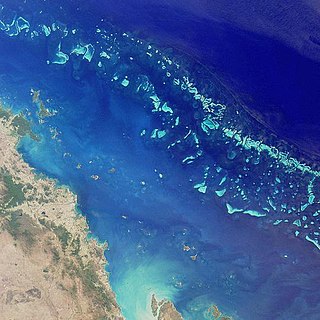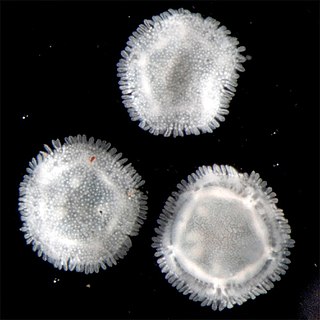Description
| | This section is empty.You can help by adding to it.(April 2010) |
| Miomelon turnerae | |
|---|---|
| Scientific classification | |
| Kingdom: | |
| Phylum: | |
| Class: | |
| (unranked): | |
| Superfamily: | |
| Family: | |
| Subfamily: | |
| Genus: | |
| Species: | M. turnerae |
| Binomial name | |
| Miomelon turnerae Dell, 1990 | |
Miomelon turnerae is a species of sea snail, a marine gastropod mollusk in the family Volutidae, the volutes. [1]
| | This section is empty.You can help by adding to it.(April 2010) |
| | This section is empty.You can help by adding to it.(April 2010) |

Marine biology is the scientific study of the biology of marine life, organisms in the sea. Given that in biology many phyla, families and genera have some species that live in the sea and others that live on land, marine biology classifies species based on the environment rather than on taxonomy.

The Great Barrier Reef is the world's largest coral reef system composed of over 2,900 individual reefs and 900 islands stretching for over 2,300 kilometres (1,400 mi) over an area of approximately 344,400 square kilometres (133,000 sq mi). The reef is located in the Coral Sea, off the coast of Queensland, Australia. The Great Barrier Reef can be seen from outer space and is the world's biggest single structure made by living organisms. This reef structure is composed of and built by billions of tiny organisms, known as coral polyps. It supports a wide diversity of life and was selected as a World Heritage Site in 1981. CNN labelled it one of the seven natural wonders of the world. The Queensland National Trust named it a state icon of Queensland.

The shipworms are marine bivalve molluscs in the family Teredinidae: a group of saltwater clams with long, soft, naked bodies. They are notorious for boring into wood that is immersed in sea water, including such structures as wooden piers, docks and ships; they drill passages by means of a pair of very small shells borne at one end, with which they rasp their way through. Sometimes called "termites of the sea", they also are known as "Teredo worms" or simply Teredo, from the Greek τερηδώνteredōn, via Latin. Eventually biologists adopted the common name Teredo as the name for the best-known genus.

Isopoda is an order of crustaceans that includes woodlice and their relatives. Isopods live in the sea, in fresh water, or on land. All have rigid, segmented exoskeletons, two pairs of antennae, seven pairs of jointed limbs on the thorax, and five pairs of branching appendages on the abdomen that are used in respiration. Females brood their young in a pouch under their thorax.

Ruth Dixon Turner was a pioneering U.S. marine biologist and malacologist. She was the world's expert on Teredinidae or shipworms, a taxonomic family of wood-boring bivalve mollusks which severely damage wooden marine installations.

Sea daisies make up an unusual group of deep-sea taxa belonging to the phylum Echinodermata, with three species described in the genus Xyloplax.

Pholadidae, known as piddocks or angelwings, are a family of bivalve molluscs similar to a clam.

Yoldiidae is a taxonomic family of small to medium-sized saltwater clams, marine bivalve molluscs in the order Nuculanida.

Corallimorpharia is an order of marine cnidarians closely related to stony or reef building corals (Scleractinia). They occur in both temperate and tropical climates, although they are mostly tropical. Temperate forms tend to be very robust, with wide and long columns, whereas tropical forms tend to have very short columns with a wide oral disc and very short tentacles. The tentacles are usually arranged in rows radiating from the mouth. Many species occur together in large groups, although there are recorded instances of individuals. In many respects, they resemble the stony corals, except for the absence of a stony skeleton. Morphological and molecular evidence suggests that they are very closely related to stony corals.
The World Register of Marine Species (WoRMS) is a taxonomic database that aims to provide an authoritative and comprehensive list of names of marine organisms.

Freshwater snails are gastropod mollusks which live in fresh water. There are many different families. They are found throughout the world in various habitats, ranging from ephemeral pools to the largest lakes, and from small seeps and springs to major rivers. The great majority of freshwater gastropods have a shell, with very few exceptions. Some groups of snails that live in freshwater respire using gills, whereas other groups need to reach the surface to breathe air. In addition, some are amphibious and have both gills and a lung. Most feed on algae, but many are detritivores and some are filter feeders.

Neptunea lyrata, also known by the common names New England Neptune, wrinkled whelk, ribbed Neptune, inflated whelk, lyre whelk or lyre Neptune, is a species of large sea snail, a marine gastropod mollusk in the family Buccinidae, and is the state shell of Massachusetts. This species consists of several subspecies.
Miomelon eltanini is a species of sea snail, a marine gastropod mollusk in the family Volutidae, the volutes.
Miomelon philippiana is a species of sea snail, a marine gastropod mollusk in the family Volutidae, the volutes.
Miomelon is a genus of sea snails, marine gastropod mollusks in the family Volutidae.

Phascolosomatidae is a family of peanut worms. It is the only family in the order Phascolosomatida, which is in the class Phascolosomatidea.

Opalia is a genus of small sea snails, marine gastropod mollusks in the family Epitoniidae, commonly known as wentletraps.

Fallacosteus turneri is an extinct species of arthrodire placoderm from the late Devonian of the Gogo Formation of Western Australia. As with almost all other camuropiscids, F. turnerae had an elongated snout that may have enhanced its hydrodynamic streamlining.
Xyloplax medusiformis is a sea daisy, a member of an unusual group of marine taxa belonging to the phylum Echinodermata. It is found at bathyal depths in waters around New Zealand. It was first described in 1986 by Baker, Rowe and Clark and is the type taxon of the genus Xyloplax. Its generic name derives from the Greek "xylo" meaning wood and its specific name was chosen because its morphology superficially resembles that of a cnidarian medusa.

Turnera subulata is a species of flowering plant in the passionflower family known by the common names white buttercup, sulphur alder, politician's flower, dark-eyed turnera, and white alder. Despite its names, it is not related to the buttercups or the alders. It is native to Central and South America, from Panama south to Brazil. It is well known in many other places as an introduced species, such as Malaysia, Indonesia, several other Pacific Islands, the Caribbean, and Florida in the United States. It is commonly cultivated as a garden flower.